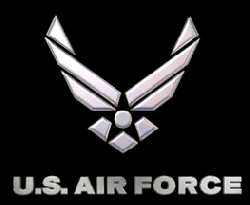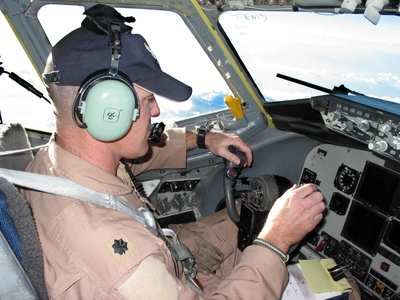USAF: Aircrew Training Ensures Air Superiority
 Superb people and state-of-the-art
technology help make the US Air Force the most formidable air power
in the world. But the general who oversees flying training for more
than 19,000 Airmen a year said the biggest single factor that makes
America's military stand out from other countries is its emphasis
on training.
Superb people and state-of-the-art
technology help make the US Air Force the most formidable air power
in the world. But the general who oversees flying training for more
than 19,000 Airmen a year said the biggest single factor that makes
America's military stand out from other countries is its emphasis
on training.
"The one common denominator that I would say makes America's
forces -- whether they're Airmen, Soldiers, Sailors or Marines --
better is our training," said Maj. Gen. Edward R. "Buster" Ellis,
19th Air Force commander here.
General Ellis is responsible for the day-to-day training of
about 2,000 US and allied students as pilots, navigators and
air-battle managers from the day they begin introductory flight
training until they arrive mission-ready at their operational
units.
"We in the United States have chosen to invest the money to make
sure that our people are trained and equipped as best as we
possibly can," General Ellis said. "And what it produces is a
capability that is matched by none other in the world."
The Air Force is leveraging technology to make sure its training
is as realistic and efficient as possible and to ensure crews know
what to expect during combat missions, General Ellis said.

Upgraded, updated training aircraft and new, high-fidelity
simulators that allow air crews to "fly" missions before ever
leaving the ground "help make sure that young man or woman has
everything going for them when (he or she goes) out there to fly
that mission," the general said.
Simulation is bringing a level of realism to training not
possible when instructors briefed students about upcoming missions
"with nothing but a word picture," General Ellis said. "Now I can
sit there with a computer, and by touching a screen, I can give you
all those words, but I can also show you pictures that show
landmarks (and) the ground track to fly" and other issues of
interest to the crew.
Threat recognition is an integral part of the training, General
Ellis said.
"We want to make sure that the first time (people) flying a C-17
[Globemaster III] into Baghdad or Tallil [Air Base, Iraq] see
someone shooting at them is not when they're doing it for real," he
said. "We want to be certain that it won't just be something
they've read about and been briefed about, but that they have had
the opportunity to 'see' it."
Other measures -- avionics, fighter data-link technology and
digital heads-up displays, among them -- are increasing aircrews'
situational awareness during missions, General Ellis said. This
allows them to focus on their mission "and come back healthy, safe
and alive," he said.
While taking advantage of technology to train its air crews,
General Ellis said 19th Air Force officials also are also looking
at other ways to make training more efficient. Beginning in
October, the combat systems officer course will teach nonpilot
aviators to become a more integral part of the crew, he said.
"They'll be more actively involved in flying the airplane than
in being limited to working the radar, doing navigation and
calculations and functions like that.
"We think it will hone their aviation skills and be a real
'value added'" for the Air Force, General Ellis said.

Similarly, General Ellis said he wants to give co-pilots more
hands-on training early in their career, reducing the need for
extensive schoolhouse training when they switch from the right seat
to become full-fledged pilots.
General Ellis said he expects the change -- a stark contrast to
what he said was sometimes a “sit down, shut up and don't
touch anything” mentality toward co-pilots -- to be "very
encouraging and rewarding" for young pilots.
"They want to be challenged," he said. "They want to do the
mission, and they want to be feel like it's worthwhile."
The war on terrorism is delivering important lessons about
flying training, particularly about importance of the people who
operate the equipment, General Ellis said.
 "It's a reaffirmation that no matter
how sophisticated the equipment and technology gets, we are still
going to need great people to do the job we do, fly the airplanes
we fly, and then come back to our schoolhouses and instruct those
people who are going out there as new pilots, weapons systems
officers, navigators [and] air-battle managers," he said.
"It's a reaffirmation that no matter
how sophisticated the equipment and technology gets, we are still
going to need great people to do the job we do, fly the airplanes
we fly, and then come back to our schoolhouses and instruct those
people who are going out there as new pilots, weapons systems
officers, navigators [and] air-battle managers," he said.
But the war is also reinforcing the need for 19th Air Force to
produce near-combat-ready air crews that require minimal follow-up
training at their gaining units, General Ellis said.
With "a very, very real-world mission going on out there" as the
United States and the coalition wage the war on terrorism, General
Ellis said he "can't imagine a more exciting time to be involved in
training."
And the bottom line in training the force, the principle General
Ellis said guides his leadership, "is to make sure that we don't
come in second place."
(ANN salutes by Donna Miles, American Forces Press
Service)
 ANN's Daily Aero-Term (04.14.24): Maximum Authorized Altitude
ANN's Daily Aero-Term (04.14.24): Maximum Authorized Altitude ANN's Daily Aero-Linx (04.14.24)
ANN's Daily Aero-Linx (04.14.24) Classic Aero-TV: 'We're Surviving'-- Kyle Franklin Describes Airshow Life 2013
Classic Aero-TV: 'We're Surviving'-- Kyle Franklin Describes Airshow Life 2013 Aero-News: Quote of the Day (04.14.24)
Aero-News: Quote of the Day (04.14.24) Airborne 04.09.24: SnF24!, Piper-DeltaHawk!, Fisher Update, Junkers
Airborne 04.09.24: SnF24!, Piper-DeltaHawk!, Fisher Update, Junkers






